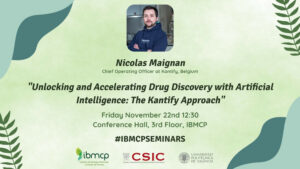John Innes Centre, Norwich Research Park, Norwich NR47UH, UK
“Cell size regulation in the meristem and beyond”
Abstract
Across biological kingdoms, cell size has important developmental and physiological roles, but its regulation remains unclear [1]. In the Arabidopsis shoot stem cell niche, cell size is one of the features that is maintained in a steady state over long periods of cell proliferation. We have found that meristem cell size is maintained by a feedback between cell growth and cell cycle progression [2], and more recently, we have revealed the underlying mechanism [3]. Specifically, the KRP4 protein associates with chromatin and consequently is distributed in equal amounts to daughter cells during mitosis. Because KRP4 is a cell cycle inhibitor, small-born cells need a longer growth period before KRP4 is sufficiently diluted to allow cell cycle progression, correcting the size variability caused by imprecise cell divisions. The use of chromatin content as a standard to assess cell size may also explain why cell size is positively correlated with ploidy and genome size. Another question we are investigating now is whether similar or different mechanisms regulate the size of other cell types, with emphasis on stomatal guard cells, whose size is an important factor in photosynthetic and water use efficiency. I will present our current approaches and results on these questions and discuss their implications.
References
- D’Ario, M. and R. Sablowski, 2019.Annu. Rev. Genet. 53: 45-65.
- Serrano-Mislata, A., K. Schiessl, and R. Sablowski, 2015.Curr. Biol. 25: 2991-2996.
- D’Ario, M., et al., 2021.Science 372: 1176-1181.
Short Bio
Plants recurrently produce new organs and tissues at their apical meristems, whose activity establishes plant architecture and is key to crop productivity. The Sablowski lab works on the genetics and cell biology of meristem and early organ development in the model plant species, Arabidopsis thaliana and in crop species (Brassica, tomato).
Growth of new organs and tissues requires active cell division and formation of specialised cell types. The Sablowski team focuses on how cell division and cell fate are coordinated with cell growth and cell size. Understanding how these processes are coordinated may lead to novel strategies to modify the size of different cell types. One example with direct relevance to plant productivity are stomatal guard cells, whose size affects the efficiency of photosynthesis and the speed at which it adjusts to changes in environmental conditions. These parameters are key to crop water use efficiency in an increasingly unpredictable environment.
Another current interest is how the stem forms in the subapical region of the shoot meristem (called the rib meristem). They use a combination of quantitative imaging, genetics and mechanical modelling to understand how genes that function in the rib meristem influence stem growth.
Ultimately, their work aims to reveal fundamental principles of plant development to allow rational modification of plant organ growth and crop performance.
https://www.jic.ac.uk/people/robert-sablowski/
If anyone is interested in meeting with the speaker, please contact Concha Gómez (cgomezm@ibmcp.upv.es).






